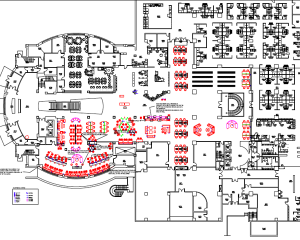The Learning Commons (Info Commons at the time) was first introduced into the Woodruff Library in 1998 as a place that combined library and information technology resources and support services in an accessible, welcoming environment for student learning and research. As the technology evolved and the needs of its users changed, so did the Learning Commons.
By 2010, the technology in the Learning Commons included over two hundred computer workstations and multiple printers (including multifunctional devices able to print, copy, and scan in both B&W and color) which filled the first four floors of the Library and handled over two hundred thousand user logins, printed nearly one and a half million pages, produced a quarter of a million photocopies, and emailed nearly a half of a million scanned pages per academic year.
The last couple of years brought considerable changes in both the technology available to students and in patterns of student learning. In particular, we are witnessing a major shift in the ways students approach and use information. They no longer simply consume the available learning resources; increasingly, the students create and actively exchange information, blending communication and learning in social interaction.
Such a shift in students’ learning patterns calls for digital mobility, which students achieve through their personal devices—laptops, tablets, and smartphones. The spike in the use of the personal mobile technology resulted in a considerable decrease in use of the Learning Commons fixed workstations: since the spring 2011, the number of student logins declined 22%. To accommodate these changes, the Learning Commons must continue to evolve.
The traditional rows and clusters of fixed computer workstations are no longer sufficient. There is a need for spaces that foster interaction and collaboration, promote creativity, support the free flow of information and peer learning. The merger of the Emory’s Libraries and Office of Information Technology into Libraries and Information Technology (LITS) under the direction of Rich Mendola in the summer of 2013 made it possible to address this need.
In the fall of 2013, UTS Student Services, Library Services Division, and Library Facilities teams began a collaborative project to design and implement the Next Generation Learning Commons. The first phase of this project aims at renovating the Learning Commons space on the main floor (Level 2) of the Library. The renovation will begin right after the commencement in May and should be completed by the Fall 2014 semester. This phase aims at creating a comfortable and flexible environment that can effectively accommodate and support student collaboration and increased use of mobile devices.
The number of fixed computer workstations on the main floor will be reduced by nearly half, resulting in a 22% reduction in the Learning Commons overall, in line with the attested decline in usage. This reduction in the number of fixed computer workstations will allow for deployment of modern mobile and comfortable furniture that will create an informal, barrier free environment, inviting the students to “land” and work in teams, blending their academic work and social engagement. The total number of seats on the main floor will be increased 15%, but taking into account the reduction in the number of the fixed workstations, the number of seats available for collaborative social interaction will increase 40%. A number of whiteboard surfaces will facilitate students’ creativity and team-based problem solving.
To foster students’ BYOD (Bring Your Own Device) experience, the Next Generation Learning Commons will compliment its robust wireless coverage with abundant access to power, providing electrical outlets for every seat in the space. As the Computing Center at Cox Hall, the well-known Emory student computing facility, will undergo its own major renovation beginning this year, the majority of its support staff will relocate to the Library.
The Student Technology Support service will provide expert in-house support for students’ BYOD technology in the Next Generation Learning Commons. The relocation of other Computing Center spaces and technology support staff to the Library will allow integrating the tested and successful Student Services support model in the Next Generation Learning Commons to ensure the best experience for its users.

